Lunar horoscope - Year of the Rooster






Chinese astrology is based on traditional astronomy and calendars. It also relies on the Chinese philosophy (theory on three harmonies, Heaven, Earth and Water) and the following principles: teaching of Wu Xing, Yin and Yang, Five Planets, 10 Heavenly Streams and 12 earthly branches, lunisolar calendar etc.
Lunar calendar is based on the cycles of moon phases. Most of these calendars represent lunisolar calendars. That means that calendar months correspond to the lunar cycles, but intercalary months are occasionally added in order to harmonize these cycles with solar years. Among these calendars are Chinese, Hebrew and Hindu calendars, and most calendar systems used in the Ancient World. Lunar calendar differs in its first day of the month. In the Chinese calendar, the first day is astronomically determined by the conjunction of the Sun and the Moon in the Chinese time zone.
The Chinese horoscope falls into the oldest known horoscopes. It consists of 12 signs of which each one rules over a lunar year. These Zodiac signs have the names of animals (Rat, Ox, Tiger, Rabbit, Dragon, Snake, Horse, Sheep, Monkey, Rooster, Dog and Wild Boar). In the Chinese horoscope, besides basic signs, very important are also elements: Wood, Metal, Water, Fire and Earth. Every person born in the year of the assigned animal is said to have personalities and traits resembling that animal.
2017 is the Chinese year of the Rooster and it starts on January 28, 2017. Previous years of the Rooster include 1921, 1933, 1945, 1957, 1969, 1981, 1993, and 2005. Rooster occupies the tenth position in the Chinese zodiac and persons born in the year of the Rooster are attentive, hardworking, and resourceful. Courageous and talented, Roosters are very confident about themselves. Roosters are always active, amusing, and popular among the crowd. They are open, honest, sincere, and loyal individuals. Roosters like being in the center of attention and expect others to listen to them while they speak. They like to brag about themselves and their accomplishments and will become agitated if others do not seem to pay enough attention to them. Roosters lead an active lifestyle, are of good health and rarely get sick, though sometimes they can be gloomy and in a bad mood.
Artistic realization of the stamps: Boban Savić, М.А, academic painter.
Easter






Easter is one of the most important Christian holidays and a movable feast. It is a day of eternal joy, the day when Christ, the Son of God, conquered death. By the act of resurrection, Jesus Christ proved his divine powers and opened the door to eternal life, joy, and happiness that can be found in our faith. On Easter Sunday the church bells ring and the people, together with their priest, walk around the church. After the third round, they all stop in front of the church. The priest carries a cross, a candle, and an thurible, and he sings the Easter liturgy. The doors open and the people go into the church where the liturgy continues. When it is over, the people greet each other with: “The Christ has resurrected”, “Indeed he has”. There are many customs related to Easter Sunday, but the one that children certainly love the most is dyeing and sharing of the eggs. The first egg is coloured in red and in many parts of our country this egg is called “The House Keeper” and it is kept throughout the whole year, until the next Easter.
This year’s commemorative issue „Easter” displays frescoes from the Church of the Virgin from the Studenica Monastery. 1986, and within the monastery complex are the Church of the Virgin, built in the distinctive Raška School of eastern medieval church architecture, founded by Stefan Nemanja (after 1183) with narthex by King Radoslav (1234), the Church of St. Nicholas, King’s Church of St. Joachim and Anne, foundations of the Church of St. John the Baptist, dining room, dormitory, and the Treasury. Church of the Virgin was painted in 1208/9, but only a small number of unchanged compositions were preserved, while a significant number of them was later altered during the restoration. The fresco “Crucifixion of Christ” created in 1209 is classified as one of the pieces with the highest artistic achievement, while the frescoes “Palm Sunday” and “The Last Supper” belong to a later period.
Motif of the stamp face value 23 RSD: “The Last Supper”, 16th century; Motif of the stamp face value 74 RSD: “Crucifixion of Christ”, west wall of the nave, 1209; Motif on the envelope: “Palm Sunday”, 16thcentury.
Expert collaboration: Serbian Orthodox Church, Eparchy of Žiča.
Graphic realization of the stamps: Nadežda Skočajić, graduated graphic artist.
100th Anniversary of Toplica Uprising

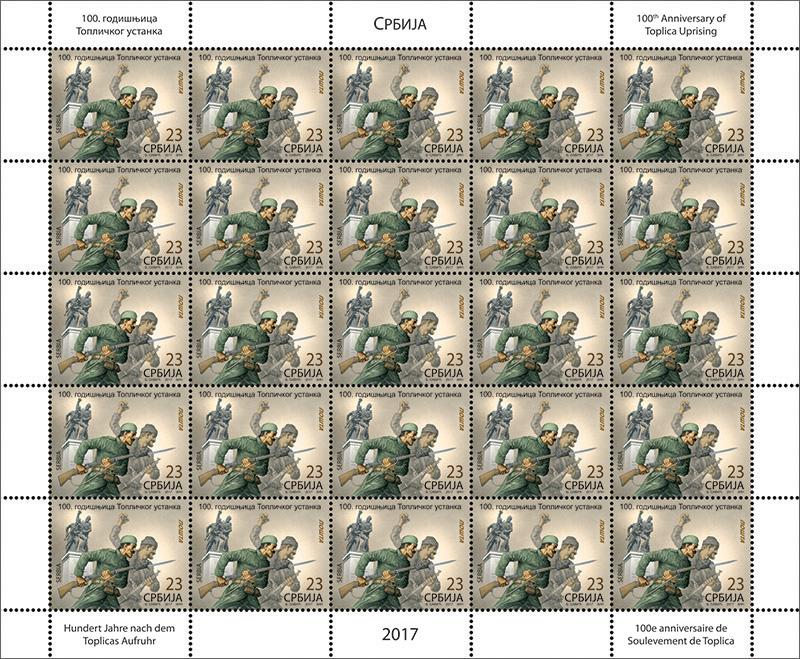


Toplica Uprising was the only uprising in the territory occupied by the Army of Central Powers in World War I, and it affected Toplica and Jablanica districts, spreading to other parts of Serbia as well. At the end of 1916, the Bulgarian occupation forces of Morava Inspection Area announced the recruitment of all males 19 to 40 years old. In Prokuplje and Toplica, the recruitment was planned for February 20-27, 1917. Those who failed to appear were faced with the death penalty. To this the Serbian population responded with the Uprising. Lieutenant Kosta Milovanović Pećanac, the renowned Duke from the troops in Macedonia (1903-12), was sent away from Salonika Front in September 1916 by the Supreme Command of the Serbian Army, with orders to start the Uprising once the Serbian Army arrives near Skopje.
The Uprising began in Kuršumlija, on February 26, 1917 and on 3rd of March Prokuplje was freed as well. The Uprising spread to the entire area of Toplica and Jablanica, Pusta Reka, Kopaonik, Ibar Valley, all the way to Rudnik and Ozren in the east.
The Serbian Army, commanded by the Dukes Kosta Pećanac and Kosta Vojinović consisted of 12,762 privates and 364 horsemen. After two weeks, the liberated territory was attacked by three occupying divisions that were withdrawn from the fronts. Kuršumlija was once again occupied by the Bulgarians on March 17, 1917 and the Uprising was finally crushed between 4th and 7th of April.
The Toplica Uprising prevented the bulgarization of those parts occupied by the Bulgarian Army, which, during the occupation of Serbia and crushing of the Toplica Uprising, violated all military laws and rules, by vandalistically destroying the culture of a nation and by trying to strip an entire nation of its national identity. According to the allegations of the 2nd Class Captain, Jovan Deroko, and according to the sources retrieved from the archives of the Historical Department of the main Headquarters, 8,767 people were killed during the Uprising, out of which 5,383 only in Toplica, and 43,484 buildings were burned.
Parliamentary Committee of Inquiry of the Kingdom of Serbs, Croats, and Slovenes, in a questionnaire conducted immediately after the war, found that in those parts of Serbia that were affected by the Uprising, 35,000 people were killed. Bulgarian occupation authorities confined about 100,000 persons from the occupied territories, almost half of which never returned from Bulgarian captivity.
Cooperation: Darko Žarić, Director of the National Museum of Toplica, senior curator historian.
Artistic realization of the stamps: Boban Savić, М.А, academic painter.
25th Anniversary of the Organization of the Black Sea Economic Cooperation (BSEC)




The Black Sea Economic Cooperation (BSEC) organization was established at the Summit of Heads of State or Government of the countries of the Black Sea region in Istanbul on 25 June 1992. The initiative brings together 12 countries of the Black Sea region – Armenia, Azerbaijan, Albania, Bulgaria, Georgia, Greece, Moldova, Romania, Russia, Serbia, Turkey and Ukraine, which with a population of more than 335 million and an area of more than 19 million square km have significant resources necessary for all-round development of the member States and the region as a whole. By bringing together Black Sea countries, BSEC strengthens economic, infrastructural, cultural and other forms of cooperation between its members, contributing to the promotion of peace and stability.
The Republic of Serbia, which attaches great importance to regional cooperation, is seeking to be a constructive BSEC member. Through its active engagement in BSEC, the Republic of Serbia is continuously contributing to the enhancement of all forms of interconnection between the countries of the Black Sea region. As its contribution to the observance of 25 years of BSEC, the Republic of Serbia dedicates this postage stamp to this anniversary.
Artistic realization of the stamp: Jakša Vlahović, academic graphic artist.
Expert collaboration: Ministry of Foreign Affairs of the Republic of Serbia.
Protected animal species



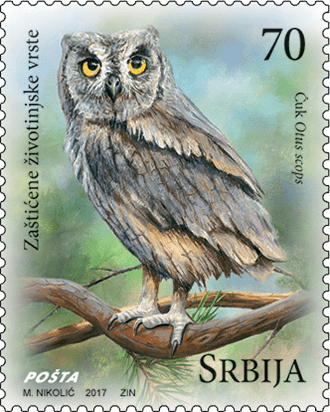




Owls
Пошта Србије пустила је у оптицај 16. марта издање пригодних поштанских марака под називом „Заштићене животињске врсте”. На четири марке овогодишњег издања које је уметнички обрадио Мирослав Николић, креатор марака Поште Србије су сове које настањују наше крајеве, кукумавка, куквија, утина и ћук. Марке носе ознаке номиналних вредности 23, 46, 50 и 70 динара, а штампане су техником вишебојног офсета у табацима од по 20 комада са вињетом у средини табака. Тираж издања, које је штампано у ЗИН у Београду је 65.000, а прате га и два FDC коверта. Жиг првога дана носи датум 16. март 2017, поштански број 11101 и назив издања „Заштићене животињске врсте”. Стручна сарадња у реализацији овог издања пружио је Милан Ружић, председник Друштва за заштиту и проучавање птица Србије – BirdLife Serbia.
Little owl (Athene noctua)
The Little owl is a small owl that prefers to live near people. It chooses open and mosaic habitats with scattered trees, pastures, rockeries, abandoned buildings, orchards, parks, farms, human settlements. It hunts large insects and small mammals, rarely amphibians and earthworms. Little owl does not build a nest but uses natural cavities in trees, walls, loess profiles, cliffs and attics. It accepts specially designed nesting boxes. It nests from April to June. In Serbia there are 14,300 to 21,000 nesting pairs, and the population is stable.
Barn owl (Tyto alba)
The Barn owl is a medium size owl with a prominent heart shaped face. It nests mainly in the lowlands of Serbia. Estimated population in Serbia is 3,400-5,100 pairs and slightly decreasing. The Barn owl chooses open habitats with plenty of grasslands where rich food sources are found. Often, it resides in human settlements. The main prey of this owl are voles, mice, rats and shrews. It nests in attics, holes in the walls, hollows of trees, or stacks of straw. It accepts specially designed nesting boxes. Barn owls nest usually once a year, but when food is plentiful there can be two clutches.
Long-eared owl (Asio otus)
The Long-eared owl is a medium sized owl that lives throughout Serbia, from lowlands to high mountains. It feeds mainly on small rodents such as voles and mice. They do not build nests, but use or take over old nests of magpies, crows and other birds. It nests from mid-March until the end of June. The estimated population in Serbia is 19,000 to 28,000 pairs and moderately increasing. During winter, Long-eared owls gather in large roosts that can count hundreds of individuals, mostly staying in human settlements.
Scops owl (Otus scops)
The Scops owl is the only true migratory bird among the owls that live in Serbia. It inhabits the whole of Serbia, from the lowlands to the hilly and mountainous areas. Habitats are open and semi-open with single trees or small groves, parks, gardens, rockeries. The main prey of the Scops owl are large insects, such as grasshoppers, crickets, beetles, and moths. It mostly chooses tree cavities for the nest, rarely man-made objects or nests of other birds. It gladly accepts bird-boxes. Nesting is from April to June. The estimated population in Serbia is 27,500 to 43,500 pairs and stable.
Artistic realization of the stamps: Miroslav Nikolić
Expert collaboration: Milan Ružić, President, Bird Protection and Study Society of Serbia - BirdLife Serbia.
Doyens of Serbian Theatre










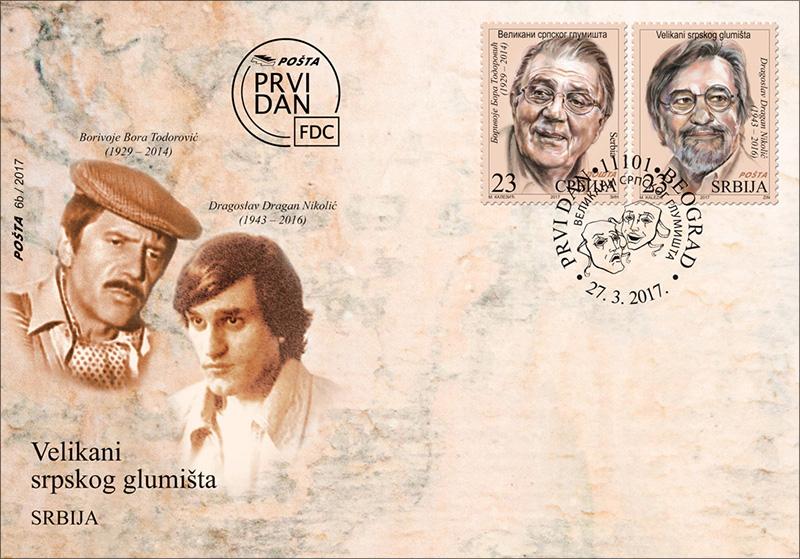




Marija Crnobori
Born in Banjola (Istria), on 1st October 1918. She completed the Actors’ Academy in Zagreb in the class of professor Branko Gavela. Her first engagement was in the Croatian National Theatre in Zagreb, then in the National Theatre in Rijeka. Invited by Bojan Stupica, she transferred to Belgrade in 1947 to then recently established Yugoslav Drama Theatre. With her mellow air and warm voice, a genuine heroine, Marija Crnobori was a unique Yugoslav actress. She could easily be both Antigone and Phaedra, Lady Macbeth, Iphigenia, Leda... She was a firm supporting column of the Yugoslav Drama Theatre repertoirе, as the theatre where she spent her best acting years. She took part in the founding of the Dubrovnik Summer Games where she played Ophelia, Gertrude, Titania... She won countless awards for her exquisite performance, of which we single out the Federal Award (1945), Belgrade October Award (1960), Sterija Award (1968), Seventh of July Award (1976), Dobrica’s Ring (1992). She wrote and published two books: The World of Acting in 1991 and A Little Life in 2011. She died in Belgrade on 21st October 2014.
Vlastimir – Đuza Stojiljković
Born on 30th June 1929 in Ražanj near Kruševac. He completed the Belgrade Drama Arts Academy and started his career in 1951 in Belgrade Drama Theatre where he performed until 1968, and then transferred to Atelier 212. He returned to Belgrade Drama Theatre in 1978, but in 1985 came back to Atelier 212 as a permanent member. He played in more than 130 roles in Belgrade theatres in the following plays: Enemy of the People, Nikoletina Bursać, Generals or Kinship in Arms, Heron, Miracle in Šargan, Maria Stewart, Fathers and Forefathers, The Beggar’s Opera, Hero’s Square… His film debut was in 1957, with a role in a film titled Foreign Land. He earned a great popularity in the movie Love and Fashion, and with a movie song titled A Little Girl he started his career as a singer. The TV series Guess What Begins with Letter… had brought about a big television popularity to him, which continued in the series that followed, such as Goodnight Children, Theatre at Home, Scales for Precise Measurement, Graduates, Čedomir Ilić and many others. The TV drama Stairways from 2015 stand as a stamp on his entire work. Vlastimir Đuza Stojiljković was a gentlemanly actor in the real sense of the word. As an actor limitlessly committed to his work, he devotedly worked together with the younger colleagues and had serious approach to the stage work, refusing to play trivial roles. He died in Belgrade on 17th June 2015.
Borivoje Bora Todorović
Born on 5th May 1929 in Belgrade. He graduated from the Belgrade Drama Arts Academy in 1956 in the class of Professor Joza Laurenčić. He was a member of the Belgrade Drama Theatre till 1957 when moved, together with Mira Stupica and Bojan Stupica, to Croatian National Theatre in Zagreb. In 1961 he returned to Belgrade, to Atelier 212 theatre where he stayed till 1990, when he came to Zvezdara Theatre. In the Atelier 212 theatre he played in the cult plays, such as Arsenic and Old Lace, Pig Trot, Bora Šnajder, Radovan III, Marathon Family, Dogs Heart; while in Zvezdara Theatre he acted in Spawning of the Craps, Larry Thompson, The Professional. He also created numerous significant film roles (Who’s That Singing Over There, National Class, The Balkan Spy...). In 2003, he won the Cannes Grand Prix for his role in the film Professional. He was also present on television. Hot Wind, Balkan Express, Grey Home, Graduates, Procreation of the Working People are some of the series in which he played. He worked with ease and tirelessness, played at the stage as in life. He won a vast number of awards, among which were also Sterija’s Award and Pavle Vujisić Award, Dobrica’s Ring Award... Bora was the embodiment of the Belgrade spirit, charm and warmth. He died on 7th July 2014 in Belgrade.
Dragoslav Dragan Nikolić
Born in Belgrade on 20th August 1943. He graduated from the Theatre, Film, Radio and Television Academy in Belgrade. In 1964, he started his film career in Belgrade, and television career in 1965 in the series It is Enough to be Silent. The main role in the film of Živojin Pavlović, When I’m Dead and Pale (1967), brought him great popularity that continued in the roles in the films Horoscope, National Class, Who’s That Singing Over There, Banović Strahinja, Something In Between, Balkan Express, The Last Lap in Monza, and many others, which brought him numerous awards. His maturity in acting was crowned by Belgrade October award in 1985. His theatre career started in Belgrade Drama Theatre, and in 1967 he transferred to Atelier 212 where he played role of Berger in Hair, directed by Mira Trailović. In Atelier 212 he performed in more than 30 plays, such as Liaison, Ziger-Zager, Dervish and Death, Tom Paine, Saint George and the Dragon, Filumena Marturano, Visitor… He won the greatest popularity by his roles in TV series and musicals: Maximeter (1970), Cheek to Cheek (1972), The Written-Offs (1974) and the Return of the Written-Offs (1976), Better Life (1990), Zona Zamfirova (2002), Wounded Eagle (2008), Jagodić Family (2012), Something Nice (2014). The legendary actor, who was depicted by the fans as a charmer, was special, both an artist and a man. He died in Belgrade on 11th March 2016.
Ružica Sokić
Born in Belgrade on 14th December 1934. As a girl, she took part in Children Radio and Drama Group at Radio Belgrade. After graduation at the Theatre Academy in 1958, she was for a short time a member of the Contemporary Theatre, from which she transferred to Atelier 212. A real diva of the Serbian acting, she engaged in her primarily comic, but also dramatic roles, adding a complex and contradictory mixture of urban and suburban character. Nothing seemed to be difficult for her, she was a real theatrical gladiator. She performed more than 200 theatre roles: Mileva (Hog’s Trot), Gospava (Miracle in Šargan), Mir-Jam, Žanka, Patricia (Female Orchestra), Tijana (The Great Drama)… She acted in 40 films (Republic of Užice, Tango Argentino, The Blond One, Forgery Original, It’s a Dark Night Out There, Zona Zamfirova, Too Tight a Hide…) and in over 100 TV comedies, dramas and series (Jelena, Elevator, Happy People, Hot Wind, Policeman from the Rooster Hill, Procreation of the Working People…). Ružica Sokić won many awards for her outstanding creations: two Sterija’s, two Golden Pula Arenas, Seventh of July, Žanka Stokić, Dobrica’s Ring, Crystal Prism, Pavle Vujisić Award for her life achievement. In 2010 she published a book titled Passion for Flying. She died in Belgrade on 19th December 2013. In October 2015, the Legacy of Ružica Sokić was opened in the Yugoslav Kinoteka in Belgrade.
Оlivera Marković
Born in Belgrade on 3rd May 1925. She used to say for herself that from an early age, she was belligerent, venturesome and ambitious. As a small girl, she founded a theatre group in which she acted, directed and managed. During the German occupation, with her peers, enthusiasts, among which was also Rade Marković, at Kolarac, and later in a private flat, she had rehearsals and performed various plays. After the war, she acted in Youth and then Academic Theatre, and was enrolled in the Drama Arts Academy as the first generation in the class of Professor Mata Milošević. She played her graduation role in 1952 in the Belgrade Drama Theatre, in the play The Last One by Maxim Gorky. She also played in Atelier 212 Theatre, the National Theatre and was a co-founder of the Belgrade Drama Section in 1961. Apart from acting, she was singing professionally, and her preference were romantic songs. She created over 150 roles. She recorded 63 films and over 80 radio and TV dramas and comedies. Among other awards, she won also two Golden Arenas in Pula, Belgrade October Award, Seventh of July Award for the most significant achievements, Dobrica’s Ring. She was a spouse of Rade Marković, the actor, and mother of Goran Marković, the film and theatre director. She died in Belgrade on 2nd July 2011.
Bekim Fehmiu
Born in Sarajevo on 1st June 1936, completed his grammar school in Prizren, and then the Theatre Academy in Belgrade, in the class of professor Mata Milošević in 1960. He was a member of the Yugoslav Drama Theatre. Even as a novice actor, he drew attention by the play Discovery, by Dobrica Ćosić. For the role of SS officer in The Condemned of Altona, play by Sartre, he recieved congratulations from author personaly. In YDT he played in the following performances: Hostage, Summer Night’s Dream, Danton’s Death, Dirty Hands, Banović Strahinja, and simultaneously he acted also in Atelier 212 Theatre, in the performances Superintendent, Egg, Marat/Sade. As Bora the White from the film I Even Met Happy Gypsies in 1967 he walked down the red carpet in Cannes. That role brings him also the title role in the Italian series Odyssey. He also acted in the Serbian films, such as The Road, Swarm, Hot Years, Special Upbringing, Deps, Košava, Protest, Partizan Squadron, Reichstag Burning, and in the international roles, such as The Adventurers (produced by Dino de Laurentis, Paramount), The Last Snow of Spring, Freedom my Love, Black Sunday, Beast Pavilion, Cagliostro, Child Named Jesus, Kitty’s Saloon, series Old and Young by Pirandello. Two decades later he returns to the theatre with the roles of Lenin and Stalin in the play Madame Kollontai with actress Rada Đuričin. He was awarded a vast number of awards in the country, such as two Arenas, Emperor Constantine, Skull Tower, while abroad he received Bergamo – for the best actor and others. He wrote the book in two volumes, Brilliant and Terrifying. He decided to leave this world on 15th June 2010.
Nikola Simić
Born in Belgrade on 18th May 1934. Even in his grammar school, he stood out with his roles in the Drama Section. Upon graduation from the Academy for Theatre, Film, Radio and Television, he got engagement in the Yugoslav Drama Theatre, where he created many roles from the comic and drama repertoire. He possessed the skill of traditional comedian and it was said that “Nikola is our Charlie Chaplin”. He will be remembered for the masterly-played role in A Flea In Her Ear, which had over 2,000 performances in 43 years of staging, as was recorded in the Guinness Book of Records. He became widely popular by playing Mita Pantić in the film serial Too Tight A Hide, but also by the roles in the popular TV series, such as: More Than A Game, Happy People, Family Treasure, Love, Habit, Panic. Nikola Simić mastered the scene sovereignly. Actors, directors and the audience could learn a lot from him. For his comic skills and unbelievable ability to modify his voice, Nikola often gave voices to cartoon characters – to name but a few: Teenage Mutant Ninja Turtles, The Smurfs and the characteristic, often repeated and well-remembered, “What’s Up, Doc?” in the Bugs Bunny cartoons. For the richness of his roles, Nikola Simić won Pula Arena and Sterija’s Award, Pavle Vujisić Award and many others. He died in Belgrade on 9th September 2014.
Expert collaboration: Saša Gruden and The Drama Artists’ Association of Serbia.
Artistic realization of the stamps: MA Marina Kalezić, academic painter.
Science






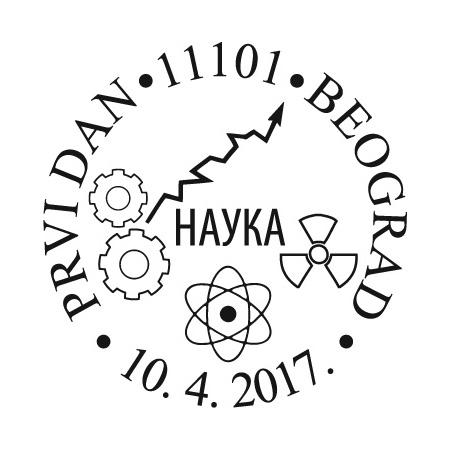
150 years since the birth of Kosta Stojanović
Kosta Stojanović (Aleksinac, 1867 – Belgrade, 1921), professor of applied mathematics at the University of Belgrade, the author of papers in the field of mechanics, physics, economics and sociology; an enlightened statesman, eight times minister in the governments of the Kingdom of Serbia and the Kingdom of Serbs, Croats and Slovenes, a negotiator at the Paris Peace Conference in 1919, a signatory to the treaty of Rapallo in 1920. His scientific method was grounded in the works of Ruđer Bošković, and he was among the first to write about him in 1891. He was the first to introduce mathematics in economic sciences, in his piece On import and export in Serbia – matter treated by a new mathematical method, published in 1902, where he calculated that Serbia loses eight dinars on each dinar of export, and developed scientific management of the national economy, which led to the victory of Serbia against Austria-Hungary in the Customs War. Afterwards, in his piece Basic Principles of the Theory of Economic Values, published in 1910, he was again the first to introduce higher mathematics in economic sciences. In his discussion paper Theory of Physical and Social Phenomena, published in 1910, he developed a general theory of society, based on thermodynamics, and established a system of categories that allow copying of the natural processes to social phenomena. His life work was completed with an unfinished attempt to give the form of mathematical laws to the First World War. He was the forerunner of cybernetics that allowed for very accurate predictions of important historical flows relevant today. He fought against the ideology of communism as a form of cosmopolitan social entropy, which undermines the moral foundations of the state. He died unexpectedly, only few days after taking over the position of the Minister of Finance, at the time when he was completing the Law on the Revision of Property of War Profiteers.
Artistic realization of the stamp: Jakša Vlahović, academic graphic artist.
Expert collaboration: Prof. Dr. Aleksandar Petrović.
150 years since the birth of Marie Curie
Maria Skłodowska-Curie (Warsaw, November 7, 1867 – Passy, July 4, 1934) was a French physicist and chemist of Polish origin, and the only woman who won the Nobel Prize twice. Marie Curie finished High School in 1883, in her homeland of Poland, and in 1891 enrolled the Department of Physics and Chemistry in Paris, at the Sorbonne University. In 1893 she finished her studies as the top of her class, and in 1906, after the death of her husband, Pierre Curie, she became the first woman to receive Professorship at the prestigious University in Paris. She won her first Nobel Prize in 1903, for scientific achievements in physics, in the study of radioactivity, together with Pierre Curie and Henri Becquerel, and in 1911 the second Nobel Prize in Chemistry, for extracting elementary radon. Her greatest achievements include work on the theory of radioactivity, radioactive isotope separation techniques, and the discovery of two new chemical elements – radium and polonium, which was named after her homeland of Poland. She was one of the founders of a new branch of chemistry – radiochemistry. In 1914, she participated in the founding of the Radium Institute in Paris (now the Curie Institute), and was its first director. During World War I, she was the Head of the Military Medical Chamber, which organized mobile X-ray stations. Marie Curie came up with a vehicle, used for radiography, which she herself drove to the front lines, and which was known among the soldiers as “Little Curie”. In order to raise funds for war supplies, Marie Curie sold both her and Pierre’s gold Nobel Medals. Marie and Pierre Curie had two daughters, Irene and Eve. Their older daughter, Irene Joliot-Curie, also received the Nobel Prize in Chemistry, in 1935, for her discovery that aluminium can be radioactive and that it emits neutrons when bombarded by the alpha rays. Marie Curie died in 1934 from aplastic anaemia, a disease caused by excessive exposure to radiation.
Artistic realization of the stamp: Jakša Vlahović, academic graphic artist.
Cities of Serbia













Belgrade
Belgrade, a meeting place and a connection point at the confluence of the Sava and the Danube rivers is one of the oldest cities in Europe and the largest in the Balkans. The place where the Pannonian Plain meets the Balkan Peninsula. It was founded by the Celts in third century B.C. During its history lasting for millennia, it was conquered by many – Huns, Ostrogoths, Sarmatians and the Avars, in the Roman Age, when it was called Singidunum.
It was the Slavs who gave its name – White City. An inscription from 878 mentions the name Belgrade for the first time (Byelgrad – Slavic form). It came to Serbian hands in 1204, and it is the capital city since 1405 and despot Stefan Lazarević.
It was attacked and taken by the Hungarians, Turks, Habsburgs… John Hunyadi lead the Christian army during the Siege of Belgrade in 1456 and managed to defend it heroically from Turks. All that time, Belgrade always preserved its self and remained characteristic. Since 1817 it was the capital of the Principality of Serbia. Prince Mihailo received the Belgrade keys from the Turkish sultan on 19th April 1867.
In the twentieth century, Belgrade was bombarded and attacked by Austro-Hungarians in 1915, and Major Gavrilović defended it street by street, offering his own and the lives of his soldiers for defence of Belgrade. It was levelled to the ground also by the Nazi airplanes on 6th April 1941, and then by the Allies in 1944. Belgrade was also bombed in 1999 in the NATO aggression against Serbia, but it survived and grew up, more beautiful and more luxurious, more joyous and happy, remembering with reverence and respect of all those who gave their lives for the Belgrade’s glory, honour and defence, through the history.
The open spirit and vast soul of Belgrade reflect in the Church of St. Sava in Vračar, built on the place where the Turks burned down the relics of St. Sava, the Serbian patron saint. Belgrade and its citizens win by their good-naturedness, smiles, hospitality and joy – at the Belgrade Marathon, Kalemegdan Terrace, in the Jevremovac Garden, in the bohemian Skadarlija, at the Sava rafts at night, in the darkness of the cinemas at the Film Festival, under the floodlights of the BITEF stage. At the beaches of Ada Ciganlija – “the sea of Belgrade”, in the leafy Košutnjak hill or at the windy Avala mountain that offers a splendorous view of the entire Serbia – one can feel the real spirit, serenity and charm of Belgrade everywhere. The city and its citizens have their hearts open for you.
Novi Sad
Novi Sad, a city nested on the northern slopes of the Fruška Gora mountain, at the very borderline between Bačka and Srem and on the banks of the Danube and the Small Bačka Canal.
The centre of Serbian culture in the past, known far and wide as Serbian Athens, Novi Sad is today the second largest city in Serbia by population and the administrative centre of the Autonomous Province of Vojvodina. It was founded by the Celts in the 4th century B.C., at the right bank of the Danube, at the location of the present-day Petrovaradin. The city was devastated by the Huns and the Avars, conquered by the Ostrogoths, Gepids and Langobards, ruled by the Byzantines and the Franks, and made part of the Bulgarian Empire and the mediaeval Hungarian Kingdom.
Novi Sad belonged to the Ottoman Empire until the Great Vienna War (1683-1699), when it was conquered by the Austrians, who prohibited the Orthodox population from living in Petrovaradin. For this reason, the Serbs founded in 1694 a new settlement on the left, Bačka bank of the Danube – Racka Varoš (Ratzen Stadt), also known as the Petrovaradin Trench (Peterwardeiner Schantz). The rich citizens of the Racka Varoš, mostly Serbs but also Germans, Jews, Hungarians, Bulgarians, Armenians and Greeks, redeemed in 1748 for 80,000 Rheinische forints their city, which became a royal free city with the official name Novi Sad (Latin: Neoplanta) entitled to autonomous judicial, executive and legislative authority, as well as to the independent tax collection.
Nowadays still, Novi Sad and its citizens live at their special, leisurely pace. It does not take much time to feel a truly tolerant, multicultural, cosmopolitan soul of the city. To fall into the rhythm and integrate in the spirit of the city, it is enough to slow down a little, relax, take a stroll from the Liberty Square where the monument to Svetozar Miletić, the City Hall and the Name of Mary Church (Roman Catholic) are located, up to the Zmaj Jovina or Danube Street, with sights like Episcopal Palace, Tanurdžić’s Palace or the City Library and Reading Room; or have a drink in the Laza Telečki Street and visit Petrovaradin Fortress and its dungeons; enjoy in the sandy Štrand, taste exquisite wines from Fruška Gora and fisherman’s soup in some of the restaurants on the Fishermen’s Island and then see one of the remarkable performances in the Serbian National Theatre; dance with the tamburitza orchestra or with the most modern music at one of the most prestigious European festivals – EXIT, visit the monasteries of Fruška Gora, enjoy in the children clamour at the Zmaj Children Games, or just enjoy in the Danube Park.
Niš
On the river Nišava, at the intersection of arterial roads and under attack of many armies and conquerors, Niš was founded by the Celts in the third century B.C. Named Fairy Town after the Fairy River (Navisos) along which it was built, it bestowed two emperors upon the great Roman Empire – Constantine the Great and Constantius III.
During the centuries, always in the crosshairs of Dardanians, Thracians, Illyrians, Celts, Romans, Huns, Avars, Byzantines, Bulgarians, Ottomans, Hungarians and Austrians, it has been an important military, commercial and administrative centre since times immemorial. Being the capital city of the Roman province Moesia Superior since the third century A.D., in the fourth century Niš (lat. Naissus) was the eparchial seat and one of the important centres of religion in the Roman Empire.
In the age of the Byzantine emperor Manuel I Komnenos, Niš was a major military base. The Grand Prince Stefan Nemanja conquered it in 1183 and restored the monastery church of St. Panteleimon, the saint protector of the city of Niš. The Ottomans under Murat conquered and looted Niš in 1386, but it needed a half century to finally fall under the Turkish rule in 1448.
In the Battle of Čegar, the Duke Stevan Sinđelić, a hero of the First Serbian Uprising, dearly charged the Turks for attempting to take the city from the hands of the rebels, taking along him to death 6,000 Ottomans, but all the remaining Serbian rebels as well. The Pasha of Niš ordered to behead all the Serbian deads and erect the Skull Tower, now a memorial dedicated to the fallen heroes of Čegar. Since 1876, Niš is a part of the Principality of Serbia. Today, it is the third largest city in Serbia, the administrative centre and the industrial hub of the Southeastern Serbia.
Coppersmith Alley, the bank of the Nišava river, the Fortress of Niš, the Skull Tower, the Monumental Banovina Palace, and Mediana, the summer villa of Constantine the Great. The spirit of the imperial Niš can also be felt during the Days of the Saint Emperor Constantine and Empress Helena, the best jazz is played every August during the Nishville Festival, and the newest movies displayed at the open stage of the Fortress of Niš during the Niš Film Gathering.
Artistic realization of the stamps: Boban Savić, М.А, academic painter.
150th Anniversary of the town keys of Belgrade being handed over to Prince Mihailo Obrenović



The First and the Second Serbian Uprising marked the start of renewal of the Serbian statehood. Prince Miloš Obrenović, during his first reign (1815-1839), skilfully reduced Turkish and expanded the Serbian authority in the area. The 1830 Edict (hatt-ı şerîf) granted to Serbia the status of autonomous principality within the Ottoman Empire. The Turkish crews remained only in Belgrade, Šabac, Smederevo, Užice, Soko Grad and Kladovo. By this, the modern Serbian state was renewed in the area where the Serbian Despotate ceased to exist in 1459. By the 1833 Edict, six nahiyes outside the Belgrade Eyalet (pashalik) were incorporated in Serbia as well.
The second rule of Prince Mihailo (1860-1868) marked the start of the decisive phase of Serbia’s struggle for independence. Armed skirmishes also broke out after the Čukur fountain incident on 16th June 1862. In accordance with the resolutions approved at the conference of ambassadors of great powers in Kanlıca near Constantinople, the Turks demolished the fortresses of Užice and Soko, reduced crew in other garrisons and displaced the Turkish populations living outside the fortresses. Prince Mihailo continued the diplomatic action for liberation of the remaining towns. On 11th April 1867 in Constantinople he received Firman from the sultan Abdul Aziz, granting him the authority to govern and protect all the towns and cities in Serbia. The Prince was ceremoniously welcomed in Belgrade on 16th April 1867. Two days later, the Firman was read to the public in the Kalemegdan Fortress. Ali Riza pasha, the last Belgrade muhafiz (custodian), symbolically handed over the keys of cities and towns to Prince Mihailo, and on 24th April 1867 was escorted to Zemun, with the last Turkish soldiers retreating with him. The Turkish flag remained the only sign of the sovereignty over Serbia, flowing along the Serbian banner upon the walls.
Motif on the stamp: Ali Riza pasha hands over the keys of the city to Prince Mihailo (Adam Stefanović, ca 1876). Motifs on the rands of the block: Belgrade in 1867 (Baron von Scholten, oil on canvas, 1867); Mihailo M. Obrenović III, Prince of Serbia (Joseph Anton Bauer, lithography, Vienna 1864); Map of the Principality of Serbia (Jovan Bugarski, Anastas Jovanović, painted lithography, Vienna 1845).
Motifs on the envelope: Belgrade (Julia Wittgens, painted lithography, Vienna 1864); Serbian delegation led by the Prince Mihailo in Constantinople 1867 (photography); Map of the Principality of Serbia (Jovan Bugarski, Anastas Jovanović, painted lithography, Vienna 1845).
Artistic realization of the souvenir sheet: MA Anamari Banjac, Academic painter.
Expert collaboration: Vladimir Tomić, Senior Curator, Belgrade City Museum.
35th Belgrade Marathon




Belgrade Marathon, the largest and the most massive sports event in our country, is held this year for the thirtieth time. By the decision of the Assembly of the City of Belgrade, Belgrade Marathon was proclaimed as the event of special importance for the City of Belgrade, which it certainly is, considering that with the 5 km Pleasure Run, half-marathon and the marathon run the start of which for years attracts the most famous athletes of the world, presents surely the biggest sports event traditionally held in our country. Within the Belgrade Marathon, four events take place, prized by the International Athletic Foundation (IAF), the World Association of Marathon and Street Runs (AIMS), and the International Association of Athletic Federations (IAAF): Children’s Marathon, Belgrade Marathon, Women’s Run and Belgrade Run through History.
Belgrade Marathon is a member of AIMS (World Association of Marathon and Street Runs), global running community, and, in its essence, is the movement of health promoting the healthy and active lifestyle among all the categories of population. Running is a simple activity accessible to everyone, easily applicable in various spaces, acceptable for both genders and all the ages, and special value of the Belgrade Marathon presents its openness towards categories of population with special needs.
30th Belgrade marathon will be remembered for the unique event titled Legends Again in Belgrade, gathering in one place, during the 30th Belgrade Marathon 2017, world-known sports stars of various generations who not only marked the athletics, but are also the synonym for the largest successes in the sports history. All of them have already been promoters of Belgrade Marathon in previous decades, and during their sports careers, they wrote the most significant pages of sports events and moved forward the limits of human achievements.
Expert collaboration: Dejan Nikolić, Belgrade Marathon Director.
Artistic realization of the stamp: MA Nadežda Skočajić, academic painter-graphic artist.
Flora






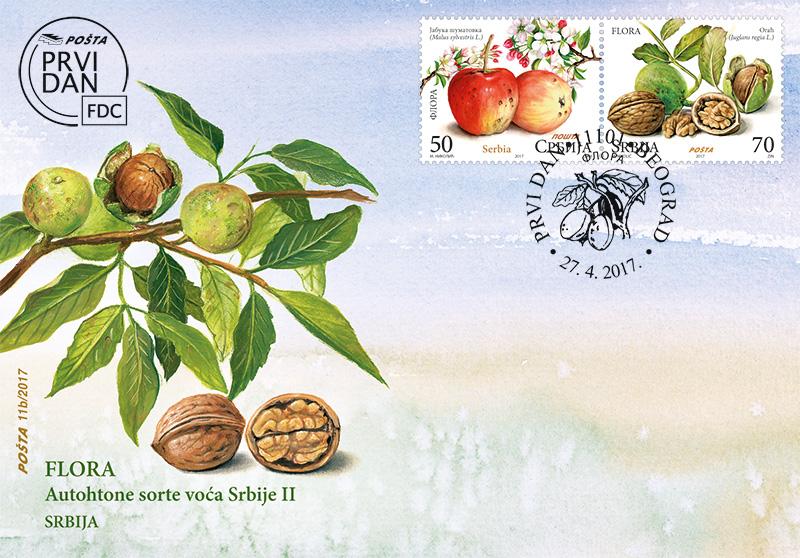

Pear Takiša (Pyrus communis L.)
Old heirloom variety of our region, of unknown origin, today almost extinct. There are two types of this sort: white and black. The white one is bigger and more widespread.
It ripens in September and the fruits can be eaten only after bletting. The fruits are small, about 25-30 in a kilogramme, with thick and coarse yellowish-brown skin. The flesh is of honey colour, crunchy, sweet, not too juicy, refreshing in taste and with fragrant aroma. This cultivar can be eaten raw or processed – it makes jam of excellent quality, but can be dried as whole fruit as well. It is disease-resistant and can be grown without protection. The tree is luxuriant, healty and long-living, with large cauldron-shape crown. The trees are high-yield and produce up to 1,000 kg of fruit per season. This cultivar is prone to biennial bearing.
Plum Požega (Prunus domestica L.)
Naturalised cultivar that originates in Asia Minor. Požegača is grown throughout Europe, but Serbia acquired high reputation in growing this variety because of the high quality of fruit grown in our geographic area.
It matures in the first half of September but can be harvested throughout that month. The tree is luxuriant and strong, with dense pyramidal crown and high fruit yield. A fruit is small to medium-sized, of irregular oval shape, dark blue, and has a dusty-white waxy coating and a shallow groove running down one side. The flesh is gold-yellow, firm, juicy, aromatic, recognizable by its sweet-sour taste, of excellent quality. It can be separated easily from the pit. The fruit can remain on the tree for a long time and survives transport very well. This variety is very susceptible to plum pox virus and highly endangered in our region. Požegača has an ideal ratio of sugars and acids, making it the highest-quality plum in the world, and perfect for making top-quality slivovitz brandy.
Apple Šumatovka (Malus sylvestris L.)
The old, autochthonous variety of our region, widespread in many regions in Serbia, especially around Vranje, in Toplica and Central Morava regions and in Kosovo. This is a real winter sort, of late ripening: it matures at the end of October and its fruits remain in fine shape until the new harvest. The tree is very luxuriant and has a narrow pyramidal crown.
The fruit is small (50-80 g), of elongated-globous shape, has a greenish-yellow basic colour of the skin, covered by the dark-red supplementary colour on the sunny side. The skin becomes oily during storage, which is beneficial to the longevity of the fruit. The flesh is whitish, firm, sweet-acid, juicy and melts on the tongue and has a characteristic flavour. It is resistant against the apple scab. The apple Šumatovka grows well in all terrains, both in lowlands and in mountain areas, and the tree is vital and resistant to pests and diseases. In full ripeness, trees may yield up to 1,000 kg of top-quality fruits per season. The tree is resistant to severe frost, but also to summer droughts and strong wind, as the fruits do not fall off. This variety of apple may grow in conditions when other cultivars cannot survive. It is suitable for growing without chemical protection and for long storage, and the fruits acquire a finer fragrance in time.
Walnut (Juglans regia L.)
Walnut is a fruit from the Northern hemisphere. It is believed that it originated in Persia. In time, it spread over Europe, Northern and Central America and Australia.
Дуговечна воћка, достиже висину до 15м и има велико и лепо стабло са разгранатом круном, а може да живи и неколико стотина година. Некада су код нас биле присутне и шуме ораха, а данас се среће у заједницама са шумама храста, кестена и граба. Орах расте појединачно или у групама, спонтано израстао или плански засађен. И поред одличних еколошких услова за плантажно гајење, орах је код нас недовољно распрострањен.
In some parts of our country certain characteristic biotypes are separated, such as moravski orah, widespread in Pomoravlje area (around the Morava river).Almost all parts of walnut (nut, shell, leaf, bark and wood) are widely used and valued in nutrition, medicine, food industry, pharmacy, cosmetics and timber industry. The nut is of great importance for nutrition, because of the high concentration of oil, proteins, minerals, iodine and vitamins. The walnut proteins can replace the proteins of animal origin. Catkins, buds and young fruits are used in preparation of various medications and preparations.
Expert collaboration: Aleksandra Savić, Senior Curator, Natural History Museum in Belgrade.
Artistic realization of the stamps: Miroslav Nikolić
125th Anniversary of the Serbian Literary Cooperative


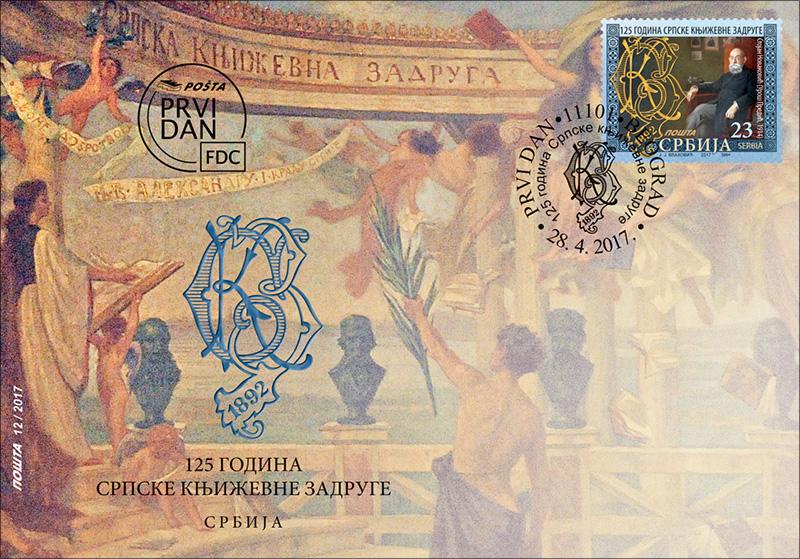
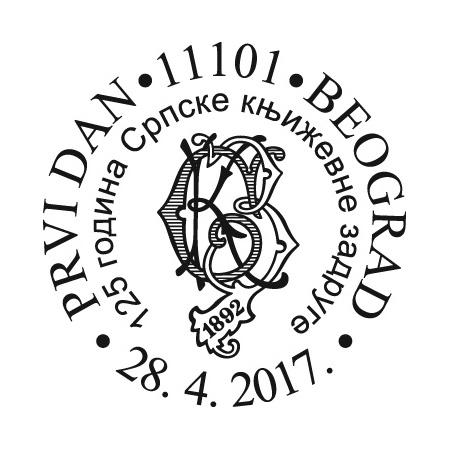
The Serbian Literary Cooperative, the oldest publishing institution of the Serbian people, was established in Belgrade in 1892 by seventeen respectable writers, scientists and scholars, among them Stojan Novaković, writer, scientist and statesman, Jovan Jovanović Zmaj, poet and physician, Ljubomir Stojanović, philologist, Milan Đ. Milićević, academician, Milan Jovanović Batut, physician and scientist, Ljubomir Kovačević, historian, and so on. The objectives of SLC were to print books, with scrutinising and professional approach and interpretation, beneficial for the people and its enlightenment and culture. Thus, the edition “Kolo” was established, every year publishing six or seven books in a variety of fields: literature above all, both Serbian and translated, history, history of art, philology and philosophy. In 125 years, “Kolo” edition has become a large anthology both of older and more recent, Serbian and world literature and science. Apart from “Kolo”, SLC nurtures another ten collections, among which especially important are the following: “Contemporary”, “Lecturer” and “Entertainer”, but also “Anthologies”, “Theoretical Thought”, “Historical Thought”, “Books for Children and Adults”. The largest scientific and research project implemented by SLC was at the same time the largest publishing undertaking: A History of the Serbian people from the Settlement of Slavs in the Balkans Until 1918 - in ten volumes. In cooperation with the Matica Srpska, SLC published the edition Serbian Literature in 100 Books, and with the Prosveta it published The Old Serbian Literature in 24 books. For 125 years, the SLC books have entered all the homes and libraries where the books are read, both in Serbia and Yugoslavia, and abroad. SLC is also a cooperative of members. The SLC membership is voluntary. From the beginning, the Serbian Literary Cooperative has been gathering together the most prominent men of letters, translators, scientists and artists. SLC is a recipient of many public awards: Medal of St. Sava of the First Order, Vuk Award, etc.
Motif on the stamp: sign of the Serbian Literary Cooperative and portrait of Stojan Novaković (oil on canvas, Uroš Predić, 1914).
Motif on the vignette and FDC: Charter of the Serbian Literary Cooperative (oil on canvas, Marko Murat, 1900).
Expert collaboration: Nina Novićević, Director of the Serbian Literary Cooperative, Belgrade.
Graphic realization of the stamp: Jakša Vlahović, academic graphic artist.
Europe – Castles


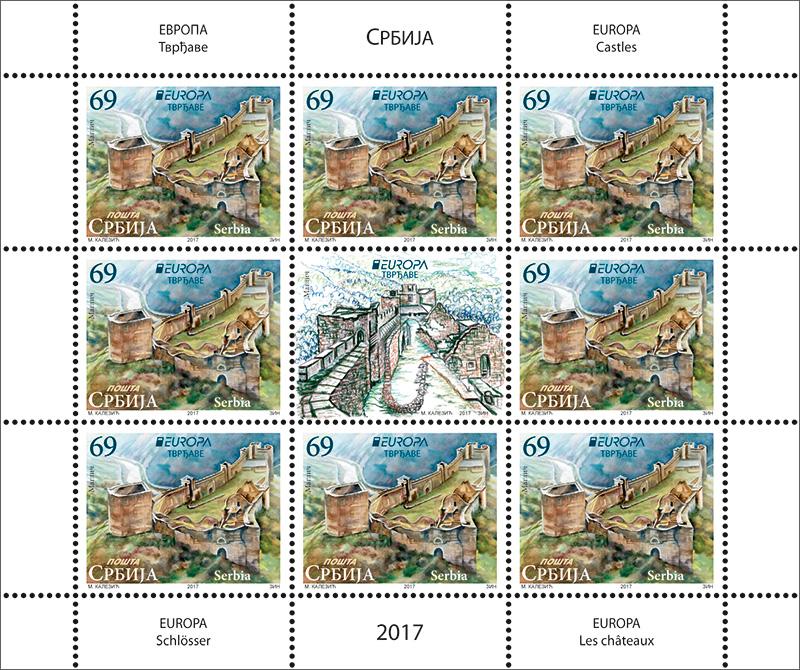



In medieval Serbia, as well as in other parts of Europe, fortresses and fortified towns were built in prominent places. As a result of the Turkish invasion in the Balkans in the second half of XIV and the beginning of the XV century, the monasteries were fortified as well, such as the Manasija Monastery (Resava). The monastery, constructed in the Morava style, is surrounded by imposing walls and eleven pinnacles. It was built by Despot Stefan Lazarević, between 1406 and 1418.
The Maglič Castle was built in the Ibar river valley, on the narrow ridge dominating the entire surroundings. The castle was probably built in the first half of the XIII century, after the Mongolian invasion into Europe. The records of it date from the time of Archbishop Danilo II, between 1324 and 1337, who reconstructed the walls, the church, the palace and other buildings. The castle lost its importance after it fell to the Turks. Maglič resumed its strategic importance at the time of the Great Vienna War (1683-1699) and the Second Serbian Uprising. The castle is surrounded by the river from three sides, while on the eastern side a moat was dug in the stone.
The Maglič Castle is built in the form of elongated rectangle, with a keep and seven massive towers ten metres tall. The interior of the castle hold the remains of the palace of the lord of the castle, archbishop’s palace and a single-nave Church of St. George. The Maglič Castle as a cultural monument was registered in the list of the immovable cultural heritage of remarkable importance in 1982.
The Smederevo Castle is one of the most impressive medieval lowland forts in Europe. It was built by Despot Đurađ Branković, near the Danube and Jezava rivers and the Petijevski stream, has a triangular base divided into the Small and the Large Towns. The Small Town was the fortified ruler’s palace surrounded by a moat and has six towers. One of them bears the inscription that the city was built in 1430. The walls on the land-facing, easily accessible side, were fortified with 19 towers, each eleven meters wide and twenty meters tall. As the cannons emerged as a new weapon, the most massive walls were erected on the southern side, in some places 4.5 metres thick. Smederevo fell to the Turks already in 1439. With his skilful diplomacy, Despot Đurađ managed to recover the city in 1444 and complete the construction by 1453. However, already in summer 1459, Smederevo fell in the hands of Sultan Mehmed the Conqueror. In 1480, the Turks added one polygonal tower in each of the three corners. The fortress and half of the town were badly damaged by the explosion of ammunition in 1941. The Smederevo Castle was registered in the list of the immovable heritage of remarkable importance in 1983.
Artistic realization of the stamps: MA Marina Kalezić, academic painter.
Expert collaboration: Dragoš Petrović, MPhil, Historian, Archive of Yugoslavia.
Museum Exibits






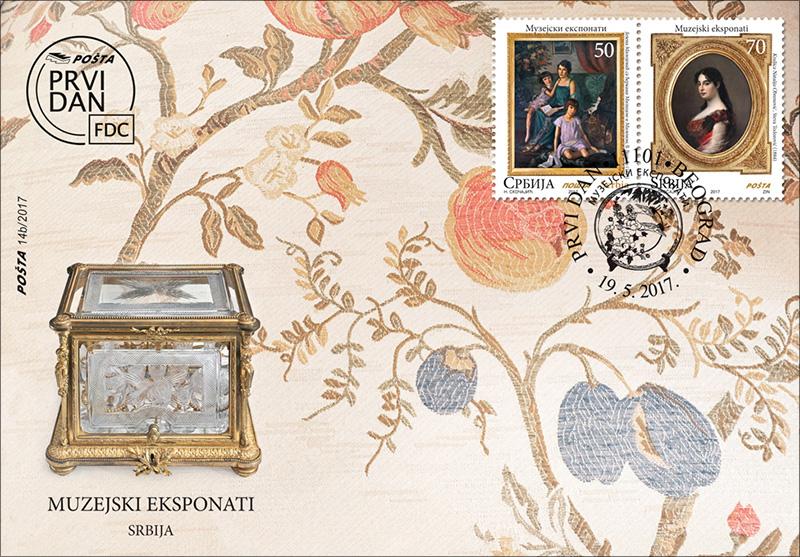

When you enter the Jevrem Grujić’s House, you take a step into the past, the Serbian tradition and avant-garde. The Serbian statesman and diplomat Jevrem Grujić (Darosava, 1826 – Belgrade, 1895), built the house for his family at the end of XIX century (in 1896) following the design made by the prominent architect Milan Kapetanović. The house was designed as a one-storey urban villa inspired by French Neo-Baroque and Neo-Renaissance. The facąde decoration is the artwork of Domenico D’Andrea, an Italian master of decorative art, and imitates sgraffitо style, very rare and almost a unique example in the architecture of Belgrade. During XIX and XX century, the Belgrade balls were organised in the state room of the house, which was also used as a gathering place for the Serbian social elite and diplomatic meetings where the political and intellectual champions of the time made decisions on the future of the young Serbian state. This is where the secret treaty between Serbia and Bulgaria for liberation of the Southern Slavs was signed in 1912, later used as a base for formation of the Balkan League. The Queen Maria Karageorgevitch visited the Grujić family unannounced and without protocol. Fifty years later, in 1967, the very first Belgrade discotheque was opened in the basement of the house, marking the start of the sociological boom in the modern history of the City. The House of Jevrem Grujić is the first cultural monument protected by the Institute of Protection of Cultural Heritage of the City of Belgrade after its foundation in 1961, and in 1979 the building was declared the cultural heritage of great significance for the Republic of Serbia. In September 2015, thanks to the generosity of heirs of Jevrem Grujić, a section of the house was made into museum, in which a part of the rich collection of Jevrem Grujić’s House is now displayed. All the exhibits, along with the archive documents, photographs and literature assert the importance of the families which have been connected and joined by this House for more than two centuries, as a symbol of familial continuity and tradition of the Serbian heritage. Now the Museum House, it is a meeting place of history and avant-garde.
Motifs: Jevrem Grujić, Steva Todorović, oil on canvas, 1888, Belgrade (stamp 1);
Mileva Naumović, Uroš Knežević, oil on canvas, 1854, Belgrade (stamp 2);
Jelena Milojević with Daughters Milica and Milena, V. Volkov, oil on canvas, 1925, Belgrade (stamp 3);
Queen Natalia Obrenovitch, Steva Todorović, oil on canvas, 1884, Belgrade (stamp 4);
French plate with perforated edge, porcelain, 1775, Lille (envelope 1);
Liqueur Chest, gilded bronze and crystal, Maison Alphonse Giroux, 1878, Paris (envelope 2 and vignette);
Chinese Glass Case, Louis XV, second half of the eighteenth century, Paris (vignette);
The Cranes, cloisonné, second half of the eighteenth century, China (vignette).
Graphic realization of the stamps: Nadežda Skočajić, academic painter-graphic artist.
Expert collaboration: Lazar Šećerović, curator of the Jevrem Grujić’s House.
European nature protection


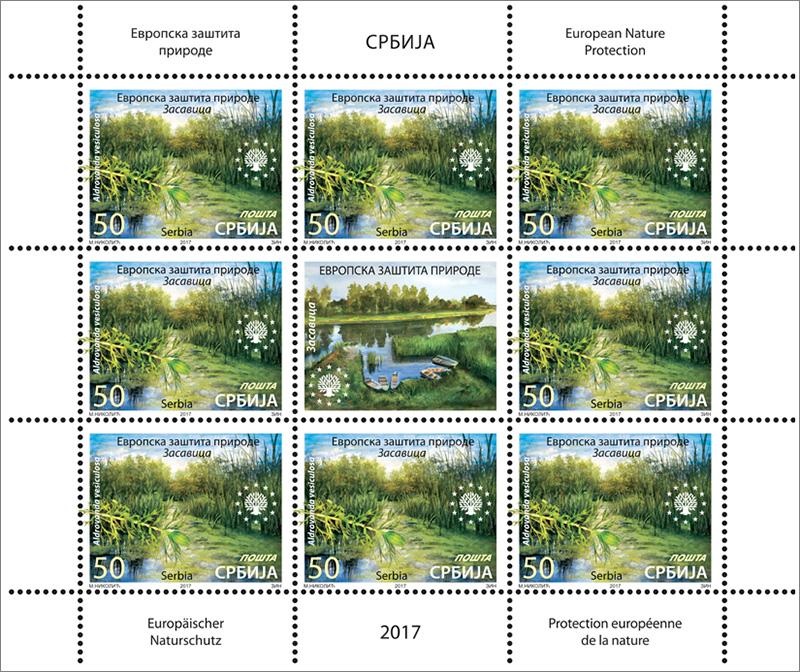



Zasavica Wetland Complex is the First Category Special Nature Reserve since 1997 and covers 1,821 hectares, of which 671 hectares are under the second level of protection. The reserve watercourse is 33.1 kilometres long, located in the Northern Mačva region, east of the Drina river and south of the Sava river, in the municipalities of Sremska Mitrovica and Bogatić, under the absolute impact of water from the Drina river.
Zasavica reserve is abundant in rare plant and animal species, some of which are on the verge of survival. More than 600 plant species, 280 fungus species, 65 mammal species, 216 bird species, 27 amphibian and reptile species, 20 fish species and more than 500 species of a variety of invertebrates are recorded. For 90 discovered flora and fauna species, Zasavica is the first finding in Serbia.
Of nearly 700 plant species in Zasavica, the most significant finding within the reserve flora is waterwheel plant (Aldrovanda vesiculosa), discovered in 2005. This plant had been recorded as extinct in Serbia for nearly 100 years, and Zasavica is its only site in Serbia. The waterwheel plant is a relict species dating from the Tertiary, found mostly in the warm waters in the tropics, where it is distributed sporadically. It is listed on the European flora Red Book; in many European countries, the plant is either extinct or endangered – it is critically endangered insectivorous (carnivorous) plant species.
The ferruginous duck (Aythya nyroca) is a globally endangered species (SPEC 1 species), whose numbers decline due to loss of habitat. On the IUCN Red List, it is listed as near threatened species around the world. Its European population is in rapid decline, and the ferruginous duck is listed as vulnerable species in Europe. In the modern period, this bird is a regular breeder in Zasavica whose nesting population is assessed at some 20-25 pairs, making 4.74% of the national population. All the researches made so far have shown that the reserve has large international importance in the preservation of overall flora and fauna.
Artistic realization of the stamps: Miroslav Nikolić
Expert collaboration: Slobodan Simić, Manager of Zasavica Special Natural Reserve.
180 years since the establishment of official diplomatic relations between Great Britain and Serbia



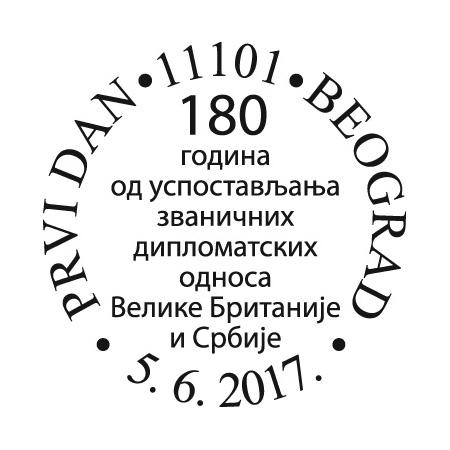
In May 1837, the sound of twelve cannons fired from Kalemegdan fortress marked the arrival to the Principality of Serbia, of the first diplomatic representative of the United Kingdom, Colonel George Lloyd Hodges, who presented his credentials to Prince Miloš Obrenović. This act formally launched 180 years of history of relations between the two countries. Many famous Serbs have lived and served in the UK: Serbian educator Dositej Obradović; Dr. Pavle Popović, writer, historian and professor at the University of Belgrade; lawyer, historian, writer and politician, Slobodan Jovanović, and writer Borislav Pekić. The British have also left their mark on Serbia: Francis MacKenzie in 1879 donated land to Serbian Orthodox Church for St. Sava Temple; Adelina Paulina Irby, Miss Irby, during the Herzegovina uprising 1874/5 and Serbian-Turkish wars 1876-1878 took care of children and refugees; Admiral Ernest Troubridge participated in the defence of Belgrade in 1915; doctor Elizabeth Ross in 1915 came to Serbia with the Scottish Women’s Hospitals, to help those sick with typhus. The Serbian Support Fund during the Great War, under the patronage of HM Queen Mary, cared for and educated Serbian children – orphans and refugees in the UK. At the end of the 20th century, director Timothy John Byford, left his mark on children’s television production in Serbia with his programmes Neven, Grandma’s grandchild and Poletarac. The enduring and complex nature of our relationship and the fact that we now stand together as allies in the face of some tough global challenges, is a testament to the strength and intensity of our friendship through the passing of time. The British – Serbian partnership is now reaching a new phase. We are working together in new areas and across borders, to make sure our relations go from strength to strength. Here’s to another 180 years!
(For creation of a text for FDC the monograph „170 years of the British-Serbian (Yugoslav) relationships”, by Dr. Čedomir Antić and Dr. Slobodan G. Marković was used)
Motif on the stamp: Portraits of Prince Miloš Obrenović (Military Museum, Belgrade) and Sir George Lloyd Hodges with Serbian and British newspapers.
Motif on the vignette: Serbia today, an article from the South Slav Journal, 1912, London; heads list of the Illustrated London Gazette, 1876.
Motif on the envelope:Britannia Pacificatrix, mural by Sigismund Goetze (Foreign and Commonwealth Office building); memorial plaque of Dositej Obradović and Miloš Crnjanski in London.
Graphic realisation of the stamp: Jakša Vlahović, academic graphic artist.
Expert collaboration: Dušan Mihajilović, the British Embassy in Belgrade.
90th Anniversary of the Serbian National Airline



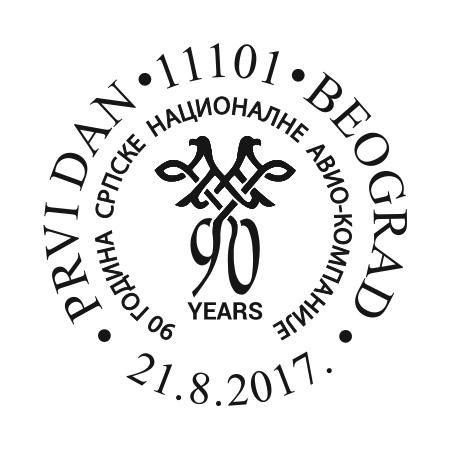
Our national airline began its life on 17th June 1927 as the first Yugoslav joint stock company for civil and air traffic, AD Aeroput. It was the tenth airline to be established in Europe and the 21st in the world. The company’s first commercial route was Belgrade – Zagreb.
Following the resumption of air traffic after the Second World War, on 1st April 1947, Yugoslav Air Transport (JAT) was created in the newly formed Federal People’s Republic of Yugoslavia, which then changed its name to Jat Airways in 2003.
A new chapter in the history of the national airline began in 2013 when the Government of the Republic of Serbia and the national flag carriers of the United Arab Emirates and the Republic of Serbia, Etihad Airways and Jat Airways, signed a Strategic Partnership Agreement. In the last four years of the strategic partnership with Etihad Airways, the national airline of the Republic of Serbia, Air Serbia, has recorded many important achievements, including re-launching flights to New York after 24 years, the introduction of a wide-body Airbus A330 aircraft to the fleet, the upgrade of its IT systems to Sabre - the most innovative platform for sales, check-in and boarding, the introduction of in-flight wireless internet through Wi-Fly, as well as the Elevate Play wireless streaming entertainment service.
Air Transport World (ATW), the leading media brand serving the information needs of the global airline and commercial air transport communities, named Air Serbia the 2017 Airline Market Leader. From its hub at Belgrade’s Nikola Tesla Airport, Air Serbia flies to a total of 42 destinations in Europe, the Mediterranean, Middle East and North America. Air Serbia also offers connections to destinations as far-off as Asia, Australia, North America and Africa in cooperation with its code share partners including Etihad Airways, its strategic partner which has a 49% ownership share. Today, the fleet of this airline consists of one wide-body, 14 narrow-body and six turboprop aircraft.
Ninety years on since its establishment, our airline is the eighth oldest carrier still in operation in the world today.
Expert collaboration: Air Serbia.
Artistic realization of the stamp: MA Nadežda Skočajić, academic graphic artist.
Ljubičevo Equestrian Games



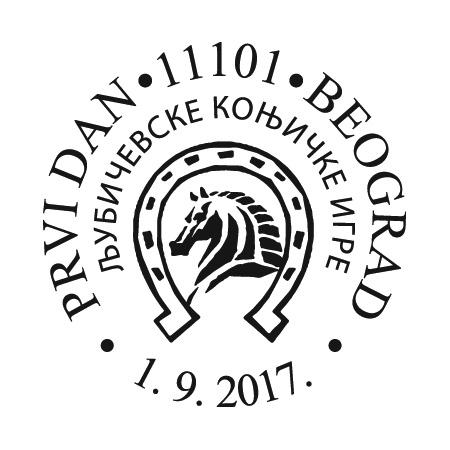
In the immediate vicinity of Požarevac, on the right bank of the Great Morava, Prince Miloš Obrenović built a summer house for his wife and children in 1858. In addition to the facility, he built several stables where he held his horses, perhaps the only private horses in Serbia in Turkish times.
Prince Miloš donated this estate, called Morava, and all the horses on it, in 1860, to the state. The horse farm which was the second largest in Serbia at the time was a part of the Horse breeding Institute Dobričevo near Ćuprija. The management of the Institute was later moved to Požarevac, and then to the Miloš estate Morava, which Prince Mihailo Obrenović named Ljubičevo in honor of his mother Ljubica.
At the beginning of the 20th century, Ljubičevo was a horse-breeding institution of the European rank, with about 500 heads of pure breed, studs from Constantinople and fillies from Austria. Over the decades, the horse farm survived numerous misfortunes of national history, but a revival always came after a tough period. On several occasions it suffered devastation, and in 1965 it was restored at the initiative of the equestrian club Veljko Dugošević.
The restoration of the horse farm was also encouraged by holding of Ljubičevo Equestrian Games, an international sports and tourist event created in 1964, as a reflection of the tradition of the people of the Stig and the Pomoravlje region, and its eternal love for the noble animal – the horse.
The beginning of Ljubičevo Equestrian Games is marked by the parade of the participants. Before the parade, previous Knight of the Ljubičevo eventing hands over the saber to the mayor of the City of Požarevac, who after the end of the Games hands it over to the new winner of the Ljubičevo eventing.
In addition to gallop and harness racing, endurance riding, equitation competition, children’s equestrian voltige, horse show and horse cart race, this event also has a unique competition in the world – Ljubičevo eventing. In this competition, brave knights on horses compete in five traditional disciplines: mace shooting, arrow shooting, spear shooting, saber cutting and courier riding. The winner is entitled the Knight of Ljubičevo, and receives the red knight's cape and the saber.
Expert collaboration: Sandra Šarčević, Graduated Geographer-Tourismmologist, Tourist Organization of the City of Požarevac and Jelena Vukazić, Graduated Philologist, Director of Tourist Organization of the City of Požarevac.
Artistic realization of the stamps: Boban Savić, М.А, academic painter.
Joy of Europe




"The Joy of Europe" is the largest and oldest international manifestation of children’s creativity, founded in 1969 on the occasion of World Children’s Day. Every year, at the beginning of October, children from many countries of Europe come to Belgrade – to play, sing, act, exhibit their artwork, but above all, to make friends and have a good time. There is almost no European country whose children, during these 48 years of the event, were not guests of Belgrade.
Part of the manifestation “The Joy of Europe” since 1998 is the International Art Contest “The Joy of Europe”, which is of a competitive character. Over time, the competition has grown beyond the borders of Europe, bringing together children and young people from all over the world, and the Children’s Cultural Center Belgrade has thus gained a rich fundus of fine arts that carry irreplacible artistic values from various cultural environments. The power of children’s artistic expression is commonly known and hides within itself the great beauty of the immediate truth, which is of utmost important necessity for modern civilization. There are more and more art studios around the world that work solely with children. There are more and more pedagogues and educators who are trying not to cannonade the children’s senses and mind, but to create a space for children’s inner life, where they will imagine, create, devise in the absence of mental noise. Artistic creativity in children is an aesthetic event in which the emotional-cognitive component is embedded, wrapped in a tangled knot of numerous emotions.
From year to year, the award winning art works testify to the authenticity of the visual culture of childhood, developing the sensibility of the audience, as well as the professional public for this form of visual expression. At the prize competition, works of children between the ages of four and eighteen in five age categories are rewarded. The best children’s works find their place on the commemorative postage stamp “The Joy of Europe”.
Motif on the stamp: drawing by Uglješa Milenković (11 years, Serbia).
Motifs on the vignettes: drawings by Hui Ka Ching (6 years, China), Mirsini Nana (11 years), Chennakesh Swathi (14 years, India), Daniel Gurka (7 years, Slovakia), Raksa Chanposri (9 years, Thailand), Neda Bosheva (6 years, Bulgaria), Jana Bugarski (11 years, Serbia).
Motif on the envelope: drawing by Lea Boutot (7 years, Taiwan).
Expert collaboration: Lidija Seničar, Editor of drawing and painting competition, Children’s cultural centre Belgrade.
Graphic realization of the stamp: Jakša Vlahović, academic graphic artist.
Christmas






Christmas is one of the most important and one of the most joyous Christian holidays, that is celebrated both by the Orthodox and Catholic believers. The difference is only in the date of the celebration; the Orthodox celebrate it on January 7th, and the Catholic on December 25th, but its message remains the same – the message of peace and love.
We celebrate Christmas for three days. It is primarily family holiday, and there are numerous traditions and customs regarding Christmas. On the day before Christmas and Christmas Eve, the yule log is being brought into house, cresset lit and hay with hidden candies, prunes, walnuts, sugar and coins, spread all over the house. The hay is a symbol of the manger in which Christ was born. The yule log represents longevity and substance of Christianity, as well as of the warmth of the love Christ brought to us when he was born and arrived to the Earth. On the very day of the Christmas, early in the morning the church bells of all Orthodox temples are ringing, announcing the nativity of Christ. People go to church to attend Christmas liturgy and they all greet each other by Christ has been born and Indeed he has.
Artistic realization of the stamp: Miroslav Nikolić.
800 years since the coronation of Stefan Prvovenčani as the First-Crowned King of Serbia




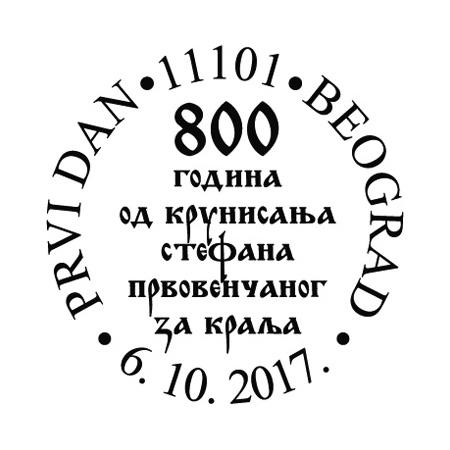
Stefan Prvovenčani (the First-Crowned, cca. 1165 - 1228), Serbian Prefect 1196 – 1217 and King 1217 - 1228, was the first crowned ruler of the Nemanjić dynasty. He was the middle son of the Grand Prefect Stefan Nemanja and the Great Duchess Anna. He inherited the throne in 1196, according to his father’s wish, who was the founder of the Nemanjić dynasty and the creator of the Serbian state. At the time of his entering the throne, he was married to Eudoxia, daughter of the Byzantine Emperor, Alexios III Angelos.
As the Grand Prefect of Raška, even under great external and internal pressure, he successfully maintained the independence of the country, and was crowned the King in 1217 by the Papal legate, which increased his reputation. After the crowning, Stefan referred to himself as „Stefan, by God’s grace, the first crowned (married) King of all Serbian lands and sea“. As the first of the Nemanjić dynasty to receive the royal wreath, he was named the „First-Crowned King“, and from that description came the name under which he is known today – Stefan Prvovenčani (the First-Crowned).
Serbia’s autonomy was completed when the Patriarch of Nikae gave autocephaly to the Serbian Church in 1219, and Sava (Rastko) Nemanjić, the younger brother of Stefan, became the first Serbian Archbishop. The monastery of Žiča, founded by Stefan Prvovenčani in 1207, became the first headquarters of the Serbian Archiepiscopacy, where latter kings were crowned and archbishops enthroned.
Stefan Prvovenčani also had a significant place in the formation of Serbian medieval literature. He wrote “The Life of St. Simeon“ (1216), a biographical work on the life and deeds of his father, Stefan Nemanja, as well as several charters characterized by a special narrative style.
At the end of his life, he received monastic tonsure, took the name Simon, and appointed his eldest son, Radoslav, as his successor.
Motif on the stamp: Stefan Prvovenčani, King, detail from the fresco in King Radoslav’s narthex, (1234), the Studenica Monastery. The motif for the first vignette: Stefan Prvovenčani as a Grand Prefect – a fragment of a painting from the entrance tower, the Studenica Monastery, 1208/9 (a fragment exhibited in the Monastery of Studenica’s treasury). The motif on the second vignette: The ring of Stefan Prvovenčani, XI – XII century, Monastery of Studenica’s treasury.
Expert collaboration: Radmila Petronijević, senior curator of the Museum of the Serbian Orthodox Church in Belgrade.
Graphic realization of the stamp: MA Nadežda Skočajić, academic graphic artist.
Stamp Day

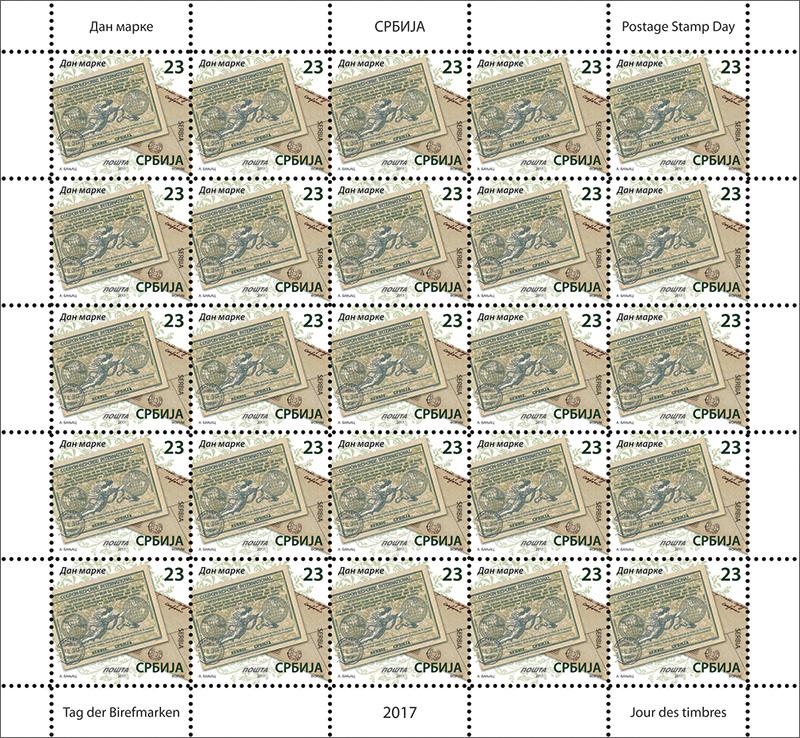


The International Reply Coupon (IRC) was introduced in the postal traffic in 1907, based on the decision of the 6th Congress of the Universal Postal Union held in Rome in 1906, as a way for people from different countries to send return mail to each other.
Early coupons bore the printed name of the country of origin, with a front-end message appearing in the language relevant to the issuing country. Since they were created before the introduction of airmail, the earliest coupons could have been redeemed for branding franchises of a regular letter sent to a foreign country.
Starting from January 1, 2002, coupons of new designs will be printed in seven languages (German, English, Arabic, Chinese, Spanish and Russian on the back and French on the front): “This coupons can be exchanged in any country of The Universal Post¬al Union for one or more postage stamps representing a mini¬mum postage for a priority letter or unregistered letter sent by airmail to a foreign country.”
International reply coupons are collected as interesting postal stationeries and postal history. The first International reply cou¬pon of Serbian origin was issued on June 1, 1917. The design of the first IRC contains an allegorical representation of a female figure that delivers mail from one part of the globe to another. This Coupon was printed by V. Benziger & Co. A. G. Einsiedeln Switzerland.
Graphic realistion of the stamp: MA Anamari Banjac, Academic painter.
Expert collaboration: Vojislav Begović.
Art












275 Years Since the Birth of Dositej Obradović
Dositej Obradović was born in 1742 in Čakovo (Romanian part of Banat) as Dimitrije. He took the monastic vows in 1758 in the monastery Hopovo, and received the name Dositej. After leaving the monastery, he went to Dalmatia, where he worked for three years as a teacher, and went on to Europe and the world, where he got acquainted with the reformist ideas of the 18th century, gained knowledge in philosophy and literature and became interested in Central European enlightenment and cultural and educational reforms. The philosophical background of his programme was the Enlightenment rationalism, adapted to the practical needs of his people. In Leipzig, he printed his programmatic essays: Letter to Haralampios (1783), Advices in Common Sense (1784) and My Life and Adventures (1793), in Moscow – Fables, in Venice Ethics and in Vienna Anthology of Various Things Moral. Having heard the news on the First Serbian Uprisal, he got in touch with Karađorđe and spent the last five years of his life in Serbia, assisting the renewal of the Serbian statehood with his knowledge, and taking active participation in international and legislative affairs. He established the Higher School – future University in 1808 in Belgrade, and the Seminary in 1810. As a member of the Governing Council, he was the first Serbian minister of education, brought Serbia closer to Europe and the world and turned it towards new cultural and civilizational trends. Dositej Obradović died on 28 March 1811 in Belgrade and is buried in the yard of the Belgrade’s Cathedral Church of St Archangel Michael.
Expert collaboration: Museum of Vuk and Dositej, Belgrade.
225 Years Since the Birth of Haji Nikola Živković
Haji Nikola Živković – Haji Neimar (Vodena (Edessa), Greece 1792 – Belgrade, 1870). It remains unknown when he came to Serbia and began his service with the Prince Miloš, but it is known that he was the manager of all the Prince’s constructions. According to legend, he was so conscientious that he knocked each brick to check its quality. Even though we do not know what was his part in the construction of structures, it is thought that he was the head designer of two konaks in Belgrade: The Residence of Princess Ljubica and The Residence of Princ Miloš in Topčider, two representative buildings of the transitory type from Oriental to Occidental (West European) architecture. During the second rule of Prince Miloš (1858–1860), he was the Supervisor of Official Establishments at the Head Administration of Construction in Belgrade. He remained in post in the newly-formed Ministry of Construction until his retirement. His role in the renewed Serbia was so important that he is rightly considered to be the first Serbia’s architect.
Expert collaboration: Belgrade City Museum.
Artistic realization of the stamps: MA Boban Savić, academic painter.
200 Years Since the Birth of Anastas Jovanović
Anastas Jovanović (1817–1899), the first Serbian lithographer and one of the first Serbian photographers. Educated in visual arts, a versatile artist, he left behind the pieces of art with exceptional value, diversity and volume.
He was born in Vratza (now in Western Bulgaria). He came in Belgrade in 1826 to became a tailor apprentice. When the National Printing House was opened in 1832, Anastas went there to learn type founding. He cut the Cyrillic letters for the first Serbian alphabet book, printed in 1838 at the order of Prince Miloš. Pleased with his work, Miloš sent him to Vienna, to study copper engraving at the St. Anna Academy. In Vienna, Anastas also studied lithography at Johan Staedler’s studio, and met with a new medium – photography. He mastered the daguerreotype, the technique of making images on a sheet of silver–platted copper, and the photographic technique of talbotype, named by Fox Talbot. In Vienna, he bought a Voigtländer camera with Joseph Petzval’s objective – Model 3, and used it to make talbotype portraits of prominent people. In Vienna, he was the first artist ever to make stereoscopic images. He made more than 200 lithographic images and over 800 photographs of people and events from the Serbian history, and made designs for the first Serbian post stamps. He was the Majordomo of the Court of Prince Mihailo Obrenović.
He died in 1899 in Belgrade.
Expert collaboration: Belgrade City Museum.
150 Years Since the Birth of Vasa Eškićević
Vasa Eškićević (1867–1933), a Serbian painter and drawing teacher, was born in Irig on January 13, 1867. He first studied barber craft, but then in 1887 he went to Vienna to attend a private painting school. In the autumn of 1893, he enrolled at the State Art School in Saint Petersburg, as a scholar of the Russian state. He also attended a private institute of the duchess Tenisheva in Saint Petersburg, in the class of a famous Russian realist, Ilya Repin, and in 1900 he was admitted to the Imperial Academy of Arts, where he graduated in 1908. He remained in Russia as a drawing teacher until World War I. When the war started, he registered himself as a volunteer and became a war painter of the First Serbian Army. He spent five years in the army and experienced the calvary of Albania, rest and refit on Corfu, and breaking of the Salonica front. He participated in the liberation of Novi Sad, where he lived until his death on January 13, 1933.
He painted in the style of academic realism with the elements of expressionism. Besides painting, he dealt with literary work and translation. He was a member of the Department of Literature of Matica Srpska. The most valuable part of his artistic heritage today is in the Gallery of the Serbian Reading Room and Library in Irig.
Expert collaboration: The Gallery of Matica srpska, Novi Sad.
Artistic realization of the stamps: Boban Savić, М.А, academic painter.
125 Years Since the Birth of Milutin Bojić
Milutin Bojić (1892–1917) was a poet, playwright, literary and theater critic. He was born in Belgrade on May 19, 1892, where he attended high school and then university. In his youth, he started publishing for Wreath (Venac), Nova Iskra, Artwork (Delo), Serbian Literary Gazette, Daily News and Piedmont. He partook in the Balkan wars, as well as the First World War. Before the war in 1914, he published his first book Poems, about which Jovan Skerlić wrote his last review. He wrote two plays: The King’s Autumn and The Marriage of Uroš, as well as a large number of literary and theater displays. He is the author of unforgettable verses about a tragic part of the Serbian history, about pain and suffering of the Serbian people. In Thessaloniki, he published a collection of poems Songs of Pride and Suffering, featuring 34 songs written in Corfu and Thessaloniki. As a witness of massive dying on the island of Vid, he wrote his most memorable song Ode to a Blue Sea Tomb, which represents a peak of Bojić’s patriotic and romantic inspiration.
He died in a hospital in Thessaloniki on November 8, 1917. He was buried at a military cemetery in Zeitenlik. His mortal remains were transferred to Belgrade around the end of 1922. Although he lived to be only 25, he left an indelible mark in Serbian literature. Expert collaboration: Matica Srpska Library, Novi Sad.
125 Years Since the Birth of Ivo Andrić
Ivo Andrić (1892–1975) was born in Travnik on October 10, 1892. He finished elementary school in Višegrad, gymnasium in Sarajevo, and studied in Zagreb, Vienna and Krakow. Due to his high school revolutionary activities for the liberation of South Slav peoples from the Austro-Hungarian authorities, he spent nine months in prison. At the beginning of his literary career he wrote poetry and lyrical prose.
In the early 1920s, he started a very successful diplomatic career, serving in Rome, Bucharest, Marseille, Paris, Geneva, and Berlin. He received his doctorate in Graz in 1924. In Andrić’s work, the interwar period was marked by short stories as the dominant genre. He spent he Second World War in Belgrade. This is when he wrote his famous novels The Bridge on the Drina, Travnik Chronicle and Miss. He received the Nobel Prize for Literature in 1961 for the “the epic force with which he traced themes and depicted human destinies drawn from his country’s history”. He died in Belgrade on March 13, 1975. He is buried in the Alley of Distinguished Citizens at the New Cemetery in Belgrade.
Expert collaboration: The Ivo Andrić Foundation.
Artistic realization of the stamps: Boban Savić, М.А, academic painter.
Children’s Stamp – Baby Zoo








The Belgrade Zoological Garden welcomed its first inhabitants back in 1936, and today it spreads over an area of seven acres of the Belgrade Fortress, and has more than 200 species and 1200 animals. According to the number of natural reproductions, the Belgrade Zoo is at the very top of Europe today.
Baby Zoo, within the Belgrade Zoo, was built in 1995 and has been home to various types of baby animals for years. It instantly became a favorite place for visitors, especially the youngest ones. They can see babies of all kinds here and sometimes even have direct contact with some of them. Here, children can play with dwarf goats, raccoon babies, baby servals, and various other species to whom the Baby Zoo is a temporary home.
Nandu
Nandu, 1.5m high and the closest relative of ostrich, is the largest bird of the South American continent. It inhabits grassy steppes and it loves places with at least a bit of high vegetation. During the mating season, nandus live in flocks composed of one male and 5-6 females. The male prepares a nest in which the females lay eggs, and there were cases when there were even 60 eggs in one nest. It is exclusively the male who sits on eggs, and who, after hatching, is the one to take care of the young. Nandu can’t fly, but has unusually long wings for a flightless bird. It uses them like an airplane rudder to avoid enemies from which it saves itself by running away or finding a suitable shelter. However, sufficiently large nandus can also bravely confront their attackers. When grown up, they can run faster than 60 km/h.
Dorcas Gazelle
It mainly inhabits the north of Africa and Israel. It is a small, graceful animal that grows up to about 1m. They live in pairs and if they have plenty of water and vegetation in the habitat, they form herds of one male and a few females. These gazelles give birth almost always to only one fawn that is born with its eyes open and spends its first days curled up in a shade. Later, it follows the mother in search of food. The male doesn’t participate in the care of the offspring except indirectly when it’s necessary to protect the herd.
Dorcas gazelles feed on leaves and herbs, and can spend all of their lives without drinking water – they can get all the necessary fluids from the plants they eat. This animal is very fast, running at speed of over 80 km/h. It is active mostly at night.
Serval
Serval belongs to the family of cats and it inhabits savannahs, dry swards, the edges of tropical rainforests, and even the Sub-Saharan mountain areas of Africa. Its body is of medium size, with an average length of 60cm. It feeds on rodents, birds, eggs, fruits, and insects. Servals are solitary animals, except when breeding. A female gives birth to 2-3 kittens, average weight of about 250g that doubles during the first 11 days. The cubs stay with their mother for up to a year before kicked out to find their own territory. Serval is known for its exceptionally long legs that allow it to jump up to 3m in height, which is why it can often catch a bird in flight.
Hippopotamus
Hippopotamus likes water, which is why the Greeks named it a river horse. It lives in African rivers, lakes and swamps, south of the Sahara. It spends up to 16 hours in the water, protecting itself from the hot African sun, and during nights it moves to the shore to graze on grass and low plants. It is graceful in water and a good swimmer, and can stay under water for 5-6 minutes. Although a solitary animal, a Hippo can form groups of up to 100 members. This is an intelligent and dangerous animal. Males are particularly aggressive in defending their territory, even towards their own offspring. Hippos mate and are born in water. The female usually gives birth to one cub, which weights about 45kg and even suckles under water. They grow up to 3m in length and can weigh up to 2.5 tons. Their lower canines (teeth) grow throughout their lives and can be longer than 50cm and weighing about 2.5kg.
Motifs on stamps and envelopes: photographs of Zoran Rajić, Marija Bojović and Nadežda Skočajić.
Expert collaboration: Srboljub Aleksić, director of the Belgrade Zoological Garden.
Artistic realisation of the stamps: Nadežda Skočajić, academic graphic artist.